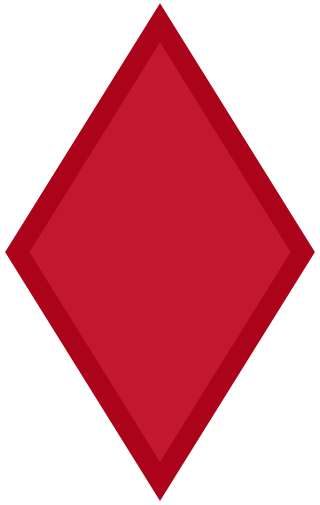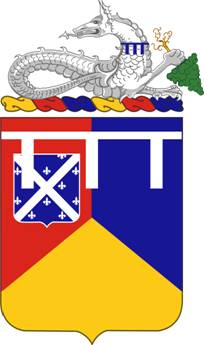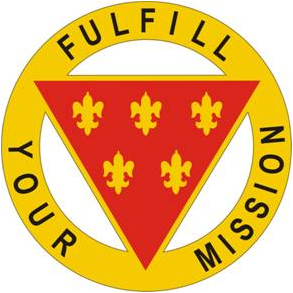The 121st Signal Battalion was a signal unit of the United States Army, inactivated as of July 2006. [1] Prior to deactivation, it provided signal support to the 1st Infantry Division. [2]
The 121st Signal Battalion was a signal unit of the United States Army, inactivated as of July 2006. [1] Prior to deactivation, it provided signal support to the 1st Infantry Division. [2]

|
|
French Croix de guerre with Palm, World War I for:
The 121st Signal Battalion was formed in 1898 as part of the United States Army Signal Corps, serving in Puerto Rico during the Spanish–American War. [3] In 1921, the two companies were reorganized as the 1st Signal Company, which was later honored with its own distinctive crest. [1]
The unit received six battle honors in World War I, symbolized by the six Lorraine crosses appearing on their coat of arms. [3] During World War II, the unit supported the 1st Infantry Division as they conducted combat operations in Normandy, France, Belgium and Czechoslovakia. During this war, the unit was awarded the Presidential Unit Citation, Meritorious Unit Commendation and the French fourragère.
In 1957, the 1st Signal Company officially re-designated to the 121st Signal Battalion. In 1962 part of the 121st was deployed to Florida during the Cuban Missile Crisis of 1962. B Company was stationed at McCoy AFB (now part of Orlando International Airport) and SGT Norman Hansen and SP4 William Hawkins Jr established communications for the infantry. Hawkins was later promoted to SGT. This was before the public was aware of a problem. The government did not recognize that they were deployed to Florida. Since then, the battalion has served with the 1st Infantry Division in Vietnam, Saudi Arabia, Bosnia and Herzegovina and Kosovo.
The battalion was deployed to Iraq with the 1st Infantry Division in 2004, returning to Germany in early 2005. Company C, the last company of the unit, was inactivated 10 April 2006, at Larson Barracks, Kitzingen, Germany.
Prior to its inactivation the unit was stationed in Kitzingen, Germany, and supported the 1st Infantry Division with MSE communications. The battalion was last deployed in operation OIF II at Tikrit, Iraq “FOB DANGER” in 2004. The unit consisted of HHC “Dangers Voice”, A (Archangels, Wired-Up!), B (Blackhawks), C (Charlie Rock), and D company. D company was stationed at Fort Riley as a rear detachment of sorts for the battalion along with the rear detachment for the 1st Infantry division. The battalion was inactivated as part of the decrease in over-seas forces that the US military is currently undergoing, the return of the 1st Infantry Division stateside and the fielding of many signal units in the signal regiment with JNN communications equipment. Alpha company was moved to Schweinfurt, Germany prior to inactivation to be stationed with the 2nd BCT, 1ID (Dagger) and was reflagged as the 57th Signal Company.
The last commander prior to inactivation was Lieutenant Colonel Dana Tankins. The last CSM was CSM Mitchell. [1]

The 5th Infantry Division (Mechanized)—nicknamed the "Red Diamond", or the "Red Devils" —was an infantry division of the United States Army that served in World War I, World War II and the Vietnam War, and with NATO and the U.S. Army III Corps. It was inactivated on 24 November 1992 and reflagged as the 2nd Armored Division.

The 95th Infantry Division was an infantry division of the United States Army. Today it exists as the 95th Training Division, a component of the United States Army Reserve headquartered at Fort Sill, Oklahoma.

The 102nd Infantry Division ("Ozark") was a unit of the United States Army in World War II. The unit is currently active as the 102nd Training Division (Maneuver Support).

The 63rd Infantry Division was an infantry division of the United States Army that fought in Europe during World War II. After the war it was inactivated, but later the division number and shoulder sleeve insignia were authorized for use by the 63rd Army Reserve Command (ARCOM).

The 9th Infantry Division is an inactive infantry division of the United States Army. It was created as the 9th Division during World War I, but never deployed overseas. In later years, it would become an important unit of the U.S. Army during World War II and the Vietnam War. It was also activated as a peacetime readiness unit from 1947 to 1962 at Fort Dix, New Jersey, and Fort Carson, Colorado, and from 1972 to 1991 as an active-duty infantry division at Fort Lewis, Washington. Nicknamed the "Old Reliables", the division was eventually deactivated in December 1991.

The 6th Infantry Division was an infantry division of the United States Army active in World War I, World War II, and the last years of the Cold War. Known as "Red Star", it was previously called the "Sight Seein' Sixth".

The 3rd United States Infantry Regiment is a regiment of the United States Army. It currently has three active battalions, and is readily identified by its nickname, The Old Guard, as well as Escort to the President. The regimental motto is Noli Me Tangere. The regiment is a major unit of the Military District of Washington (MDW).
The 47th Infantry Regiment is an infantry regiment of the United States Army. Constituted in 1917 at Camp Syracuse, New York, the regiment fought in the Great War, and was later inactivated in 1921. Reactivated in 1940, the regiment fought during World War II in North Africa, Sicily, and Western Europe, then was inactivated in 1946. During the Cold War, the regiment saw multiple activations and inactivations, with service both in the Regular Army and the Army Reserve; it fought in Vietnam. Ultimately it was reactivated as a training regiment, and as of 1999, it has been assigned to Fort Moore and consists of two active battalions.

The 66th Armor Regiment is the oldest armored unit in the United States Army, tracing its lineage to the 301st Tank Battalion which served with distinction soon after it was formed in the First World War; the 301st trained at Camp Meade, Maryland, where then Cpt. Dwight D. Eisenhower was an instructor. It has often been rumored that the 301st, the parent unit of the 66th, was first commanded by Col. George S. Patton, but this appears not to have been the case; while Patton was the first officer assigned to the Tank Corps, and while the 301st Tank Battalion was the first unit formed, Patton went nearly immediately to France to train Americans attached to Allied commands. The 301st was the only American heavy tank battalion to have seen action in the war. After the war, the 301st transitioned in the Regular Army to become the 66th Infantry Regiment by way of the 16th Tank Battalion.

II Field Force, Vietnam was a United States Army Corps-level command during the Vietnam War.

The 87th Infantry Regiment is an infantry regiment in the United States Army. The regiment's 1st and 2nd Battalions are light infantry units assigned to the 1st and 2nd Brigade Combat Teams respectively of the 10th Mountain Division located at Fort Drum, New York. The 3d Battalion was active in the U.S. Army Reserve in Colorado. The 4th Battalion was a Regular Army unit assigned to the 3rd Brigade Combat Team of the 25th Infantry Division (Light) at Schofield Barracks, Hawaii.

The 1st Infantry Division is a military formation of the Republic of Korea Army's I Corps. The division was established on 1947 under the command of Colonel Kim Suk-won.

The 194th Armored Brigade is a separate brigade of the US Army. All armor, cavalry, and armor and cavalry mechanic soldiers, and Marines in equivalent specialties, are trained by the 194th under the armor component of the Maneuver Center of Excellence at Fort Moore, Georgia, where the 194th has been garrisoned since 2012.

The 11th Infantry Brigade is an inactive infantry brigade of the United States Army. It was first formed as part of the 6th Division during World War I. It is best known for its service with the 23rd Infantry Division from 1967 through 1971 in the Vietnam War as a light infantry brigade. The brigade is known for its responsibility in the My Lai Massacre.
The 3rd Field Artillery Regiment is a field artillery regiment of the United States Army, first formed in 1812, although regimental units trace their lineages as far back as 1794. Based on the service of these antecedents, the regiment claims battle honors for the War of 1812, the Seminole campaign, the Mexican War, the Civil War, the Spanish–American War, and the Philippine Insurrection. The regiment served with the 6th Division during World War I, with the 5th Division, 6th Division and 2d Cavalry Division between the world wars, and with the 9th Armored Division during and after World War II. Since 1961, the regiment has been a parent regiment under the Combat Arms Regimental System and the U.S. Army Regimental System, with regimental elements serving with the 1st, 6th, and 8th Infantry Divisions; 2nd and 3rd Armored Divisions; 1st Cavalry Division; 194th Armored Brigade; and various field artillery brigades and groups. Two regimental battalions are currently active: the 2nd Battalion in the 1st Armored Division and the 5th Battalion in the 17th Field Artillery Brigade
The 8th Field Artillery Regiment is a field artillery regiment of the United States Army first formed in 1916. The regiment served in World War I, World War II, and Korea, and regimental units have served in Vietnam, Honduras, Panama, Operation Desert Storm, Operation Enduring Freedom and Operation Iraqi Freedom. Currently organized as a parent regiment under the U.S. Army Regimental System, the regiment's only active component is the 2nd Battalion, 8th Field Artillery Regiment, currently assigned to the 1st Infantry Brigade Combat Team, 11th Airborne Division and stationed at Fort Wainwright, Alaska.
The 9th Field Artillery Regiment is a field artillery regiment of the United States Army first formed in 1916. The regiment served in Hawaii during World War I, 3rd, 4th, 7th, and 9th Divisions between the world wars, and with 3rd Infantry Division during World War II and Korea. Since 1957, the regiment has been a parent regiment under the Combat Arms Regimental System and the U.S. Army Regimental System, with regimental elements serving with the 3rd, 4th, 10th, 25th, 79th, 83rd, and 96th Infantry Divisions and various field artillery brigades and groups. The regiment's single active component, the 1st Battalion, 9th Field Artillery Regiment, is assigned to the 2nd Brigade Combat Team, 3rd Infantry Division and stationed at Fort Stewart, Georgia.

The 32nd Field Artillery Regiment is a distinguished and highly decorated field artillery regiment of the United States Army, first Constituted in 1918.

The 3rd Infantry Division Artillery (DIVARTY) is the divisional artillery command for the 3rd Infantry Division at Fort Stewart, Georgia. The DIVARTY has served with the division in World Wars I and II, the Korean War, Operation Iraqi Freedom, and in peacetime at Fort Stewart and Germany. The DIVARTY was inactivated in 2004 as part of transformation to modular brigade combat teams, but was reactivated on 17 October 2014 to provide fire support coordination and mission command for the training and readiness of Field Artillery units across the division.

The 69th Infantry Brigade was a brigade of the Kansas Army National Guard and Nebraska Army National Guards, which saw service with the 35th Infantry Division during World War I.
![]() This article incorporates public domain material from 121st Signal Battalion Lineage and Honors. United States Army Center of Military History.
This article incorporates public domain material from 121st Signal Battalion Lineage and Honors. United States Army Center of Military History.